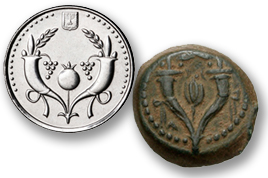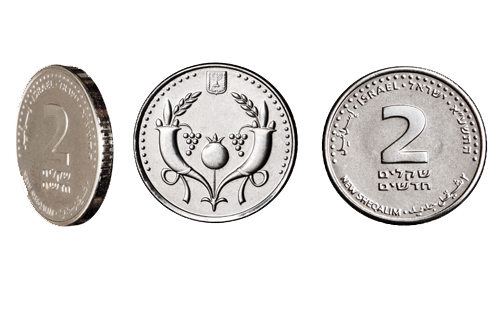If there is one Jewish holiday that can bring delight to numismatists, it is Hanukkah. Not only because of Hanukkah gelt — coins given as gifts to children or won in dreidel competitions — but also because of the the Hasmonean dynasty that followed the successful Maccabean revolt. The Hasmoneans minted coins and many of the motifts on those ancient coins are to be found on present-day Israeli currency. In fact, all Israeli coins, from the very first mintage in 1948, are modeled after ancient Jewish coins or other Jewish archeological artifacts.
During this week’s Hanukkah holiday, the Bank of Israel (BOI) is opening its doors and inviting the public to an exhibition about the history of means of payment and the conduct of trade during various periods. The BOI visitors center presentation spans the pre-coin periods, via the invention of the first coins in the seventh century BCE, and up to the present day. Many of the 400 items in the exhibition are rare and exclusive to the BOI collection.
The exhibition focuses on coins in circulation in the Land of Israel down the centuries, starting with the first coins, minted by the Lydians in western Asia Minor and coins from ancient Greece, the civilization that pioneered the widespread use of coins.
Alongside these are coins of the Persian Empire and of Judaean cities from the Persian period in the fourth century BCE.
Ancient coins are shown in chronological order, from the Hellenistic, Roman, and Byzantine periods to the Ottoman era, with emphasis on Jewish coins from the Hasmonaean and Herodian periods, and from the time of the Jewish rebellion against Rome and of the Bar Kokhba war.
There are also two hoards, one found in the wreck of a sunken vessel, and the other, the savings of a wealthy inhabitant of Maresha, unearthed in archaeological excavations near Beth Guvrin.
The exhibition also displays all of Israel’s banknotes and coins from the British Mandate period to the present day. Next to each coin is a photo of an ancient coin on which the motif of the modern coin is based.
2 NIS coin (above), based on a coin (below) from the era of John Hyrcanus I (127 BCE to 104 BCE).
A separate display presents emergency money printed in Jerusalem by the British Mandate Government in the early 1940s, including trial print runs and original artwork for banknotes that were never put into circulation and were destroyed; these are specimens of the only banknotes ever printed in Jerusalem.
The numismatic exhibition covers various other topics, such as money substitutes that were used in ancient and contemporary civilizations.
The visitors center includes interactive activity stations with computer games that explain the BOI’s functions, the history of money, and the contribution of the central bank to the economy. There are also films on the development of the means of payment and the essential role of the BOI in safeguarding and maintaining price stability.
In addition, visitors will also be introduced to the new currency series now being put into circulation, including the production process and anti-forgery security measures.
http://youtu.be/WA4rZeGmrZM?list=UUhJvckHJmDDQu3ujhGNJ5bg
The Bank of Israel visitors center will hold four daily tours this week at 9:30, 11:00, 12:30, and 14:00, on December 17-18 and 21-23. The tour is suitable for adults and children aged eight and up, and takes about an hour and a quarter. Admission is free but advance registration is required as space is limited. For more information, visit the Bank of Israel website.
















